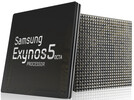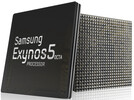Samsung Exynos 5430 Octa vs Samsung Exynos 5410 Octa
Samsung Exynos 5430 Octa
► remove from comparison
The Samsung Exynos 5430 Octa (also called Exynos 5 Octa) is a system-on-a-chip (SoC) for smartphones and tablets. It was launched in mid-2014 alongside the Samsung Galaxy Alpha and features four Cortex-A15 cores clocked at up to 1.8 GHz. Furthermore, there are four additional Cortex-A7 cores at up to 1.3 GHz, an ARM Mali-T628 MP6 GPU and a 2x 32 bit LPDDR3(E)-2133 memory controller up to 14.9 GB/s. As the SoC lacks an internal cellular modem, an additional module will be necessary for use in smartphones.
Processor
Compared to the commonly used Cortex-A9 and Cortex-A7 architecture, the A15 cores offer an at least 50 percent better performance per clock as well as relatively high frequencies, which makes the Exynos 5430 one of the high-end ARM SoCs of 2014. On average, the CPU performance is roughly on par with the Qualcomm Snapdragon 801 or Nvidia Tegra 4. Compared to the very similar Exynos 5420 (28 nm), the more efficient 20 nm process allows a better utilization of the clock headroom leading to a slightly higher performance.
In addition, Samsung has integrated four Cortex-A7 cores clocked up to 1.3 GHz. Depending on the system load, the SoC will automatically switch between the more powerful A15 cores and the more efficient A7 cores to improve power consumption and battery life in a concept ARM calls "big.LITTLE". Similar to previous models, all eight cores can be used simultaneously, so that the chip can be described as a "true" octa-core SoC.
Graphics
Just like the Exynos 5420, the Exynos 5430 integrates a Mali-T628 MP6 GPU, which offers six shader clusters clocked at up to 600 MHz (122 GFLOPS). The Mali-T628 supports OpenGL ES 3.0, OpenCL 1.1 and DirectX 11 and offers a performance that is just sligthly behind the Adreno 330 (Snapdragon 801) or a PowerVR G6430 (Apple A7). However, Nvidia's Tegra K1 or the Apple A8 are even faster. Nevertheless, the GPU can run even the most demanding Android games at high resolutions (up to 2560 x 1600 pixels) and detail settings.
Power Consumption
Thanks to a new 20 nm process, the Exynos 5430 is significantly more efficient than the Exynos 5420 and other 28 nm high-end SoCs. Overall, the power consumption is still relatively high and best suited for medium-sized (or bigger) smartphones as well as tablets.
Samsung Exynos 5410 Octa
► remove from comparison
The Samsung Exynos 5 Octa (also called Exynos 5410) is a system on a chip (SoC) for smartphones and tablets introduced in early 2013. Its first major application is the Samsung Galaxy S4. The SoC offers four Cortex-A15 cores clocked at 1.6 to 1.8 GHz. Compared to the commonly used Cortex-A9 architecture, the A15 cores offer roughly 50 percent higher performance per MHz, which makes the Exynos 5410 one of the fastest smartphone SoCs of 2012. In addition, Samsung has integrated four Cortex-A7 cores, which are much more efficient and clocked at up to 1.2GHz. Depending on the load, the SoC automatically switches between the A7 and A15 cores to improves power consumption and battery life. This concept, developed by ARM, is called "big.LITTLE". It is theoretically possible to address all 8 cores simultaneously.
The PowerVR SGX544 GPU is licensed by IMG (Imagination Technologies). The Exynos 5410 integrates the MP3 model, which offers a total of 3 GPU cores clocked at 533 MHz (51.2 GFLOPS). The SGX544 supports OpenGL 2.1, OpenCL 1.1 and DirectX 9.0 and performs similarly to the Adreno 320 as found on Qualcomm's Snapdragon S4 Pro. Compared to the fastest tablet SoCs like the Apple A6X or the Exynos 5250, the Exynos 5410/SGX544MP3 falls a bit short. Nevertheless, Android games will play fluently even in 1080p.
To be suitable for smartphones, the Exynos 5 Octa should have an estimated maximum TDP of about 3 to 4 Watts. It is possible for full load to cause slight throttling, which is common amongst SoCs.
| Model | Samsung Exynos 5430 Octa | Samsung Exynos 5410 Octa | ||||||||||||||||||||||||
| Codename | Cortex-A7/-A15 | Cortex-A7/-A15 | ||||||||||||||||||||||||
| Series | Samsung Exynos | Samsung Exynos | ||||||||||||||||||||||||
| Series: Exynos Cortex-A7/-A15 |
|
| ||||||||||||||||||||||||
| Clock | 1800 MHz | 1600 - 1800 MHz | ||||||||||||||||||||||||
| L1 Cache | 0 MB | 0 MB | ||||||||||||||||||||||||
| L2 Cache | 0.5 MB | 0.5 MB | ||||||||||||||||||||||||
| Cores / Threads | 8 / 8 | 8 / 8 | ||||||||||||||||||||||||
| Technology | 20 nm | 28 nm | ||||||||||||||||||||||||
| Features | ARM Mali-T628 MP6 GPU (600 MHz), 4x Cortex-A15 (1.8 GHz) + 4x Cortex-A7 (1.3 GHz, big.LITTLE), 2x 32 Bit LPDDR3(E)-2133 Memory Controller | PowerVR SGX544MP3 GPU, 4x Cortex-A15 + 4x Cortex-A7 (big.LITTLE), LPDDR3-Controller | ||||||||||||||||||||||||
| iGPU | ARM Mali-T628 MP6 (? - 600 MHz) | |||||||||||||||||||||||||
| Architecture | ARM | ARM | ||||||||||||||||||||||||
| Announced | ||||||||||||||||||||||||||
| Manufacturer | www.samsung.com | www.samsung.com |
Benchmarks
Average Benchmarks Samsung Exynos 5430 Octa → 100% n=2
Average Benchmarks Samsung Exynos 5410 Octa → 78% n=2
* Smaller numbers mean a higher performance
1 This benchmark is not used for the average calculation












